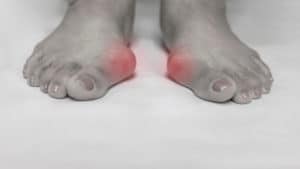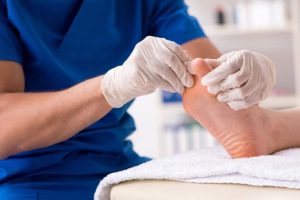Information From The American Podiatric Medical Association
 Heel pain sometimes results from excessive pronation. Pronation is the normal flexible motion and flattening of the arch of the foot that allows it to adapt to ground surfaces and absorb shock in the normal walking pattern.
Heel pain sometimes results from excessive pronation. Pronation is the normal flexible motion and flattening of the arch of the foot that allows it to adapt to ground surfaces and absorb shock in the normal walking pattern.
As you walk, the heel contacts the ground first; the weight shifts first to the outside of the foot, then moves toward the big toe. The arch rises, the foot generally rolls upward and outward, becoming rigid and stable in order to lift the body and move it forward. Excessive pronation—excessive inward motion—can create an abnormal amount of stretching and pulling on the ligaments and tendons attaching to the bottom back of the heel bone. Excessive pronation may also contribute to injury to the hip, knee, and lower back.
If you are experiencing excessive pronation, contact one of our Doctors at the Precision Foot and Ankle.
Why does the Foot Pronate?
Pronation is the normal flexible motion and flattening of the arches of our feet that allow them to adapt to ground surfaces and absorb shock when we are walking normally. In a proper stride, the foot should roll forward from heel to toe and pronation should be neutral. Your weight should be balanced on your feet.
But when our foot either leans outward (supination) or inward (pronation) to an excessive degree, the continued misplaced stresses can lead to various injuries. On this page, we’re looking at overpronation.
WHAT PEOPLE SAY
What Injuries can be Caused by Excessive Pronation?
When the arch of the foot collapses excessively downward or inward, this is known as overpronation. Colloquially you may have heard this called “flat feet.” The way the person’s foot strikes the ground when their feet overpronate can have significant effects on the body leading to various injuries. This is because the condition disrupts the body’s natural alignment and causes increased impact when the foot strikes the ground.
These injuries are common in people with overpronation, particularly athletes:
- Shin splints
- Bunions
- Plantar fasciitis
- Iliotibial band syndrome (inflammation of a ligament on the outside of the knee)
- Heel pain
- Chronic lower back pain
- Stress fractures in the foot or lower leg
- Patellofemoral pain syndrome
- Achilles tendonitis
What causes OIverpronation of the Foot?
There are a few different reasons why a person would overpronate while walking or running. These are the most common causes:
- Genetics — For some people, overpronation has a genetic predisposition and is present from childhood. Some overpronation is normal in very young children, however, since the arch of the foot doesn’t develop fully until about age six.
- Flat Feet — People who have very flat feet or a collapsed arch tend to overpronate. Flat feet can develop because of genetics, standing for long periods of time, or wearing unsupportive footwear like flip-flops or slippers.
- Wear and Tear — Overuse, strain, and wear on the muscles, ligaments, and arches of the feet can cause the feet to flatten too much. A damaged arch is one of the leading causes of overpronation.
- Worn or Unsupportive Footwear — Wearing shoes that don’t fit, don’t have proper arch support, or slide around while you walk all cause the arch to flatten and roll inward excessively. Also, standing and walking in high heels for long periods of time puts a lot of strain and pressure on the arch and surrounding ligaments and muscles.
How is Overpronation Diagnosed by Your Podiatrists?
 It’s usually not difficult for our four podiatrists at Precision Foot and Ankle to diagnose overpronation.
It’s usually not difficult for our four podiatrists at Precision Foot and Ankle to diagnose overpronation.
First, we look at your arches. We have you place your bare feet flat on the floor and we check the arch. If there isn’t any space between the sole of your foot and the floor, it’s likely overpronation.
Next, we’ll have you perform a “gait test.” You will walk or run on a treadmill or using instruments called force plates. These measure the amount and timing of your pronation.
How is Overpronation Treated?
At Precision Foot and Ankle, we address overpronation with various treatment approaches. The main treatment options are:
- Supportive shoes
- Wearing orthotics
- Performing exercises that strengthen the arches and muscles around them
Supportive Shoes
If you’re prone to overpronation (pardon the pun), you need to be very particular when selecting new shoes. This is especially important when buying shoes for running or walking. You’ll want to look for shoes that offer extra support and stability, so the shoes minimize the impact of each step. When shopping, you need to wear thin socks and you should shop at the end of the day where your feet are a little puffy. Any good running store offers some form of walking-style analysis. We can also recommend various shoes that can help with overpronation.
Orthotics
Orthotics are one of the common treatments we use for overpronation. These custom-made inserts slip into your shoes to provide extra arch support and help minimize the impact of the way you walk.
Physical Therapy
We may prescribe physical therapy for strengthening exercises. The goal is to build the muscles that support the arches. These are some sample exercises that will be part of your PT regimen:
- First Position Demi Plié — With your feet turned out from your hips, so the feet angle outward and your heels are together, bend your knees while keeping your heels on the floor. Slowly lower and then raise back up.
- Rolling the feet — Stand with your feet at hip-width apart. Roll your weight to the outside of the feet and then back to normal position.
- Seated Calf Stretches — Tight calf muscles place too much stress on the Achilles tendons, which worsens flat feet. Stretch your calf muscles by sitting with your legs extended in front of you with feet flexed. Hinge forward at the waist and reach for your toes.
Schedule a Client Consultation - Utah Podiatrist
If you are experiencing Excessive Pronation, contact one of our doctors at the Precision Foot and Ankle.

